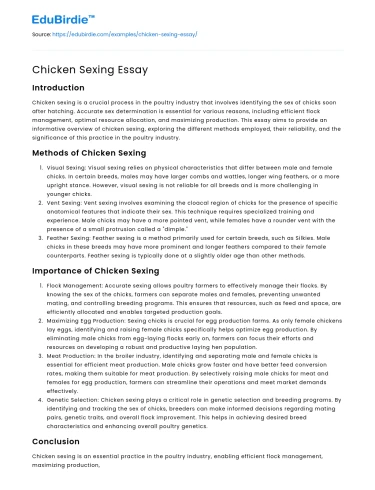Introduction
Chicken sexing is a crucial process in the poultry industry that involves identifying the sex of chicks soon after hatching. Accurate sex determination is essential for various reasons, including efficient flock management, optimal resource allocation, and maximizing production. This essay aims to provide an informative overview of chicken sexing, exploring the different methods employed, their reliability, and the significance of this practice in the poultry industry.
Methods of Chicken Sexing
- Visual Sexing: Visual sexing relies on physical characteristics that differ between male and female chicks. In certain breeds, males may have larger combs and wattles, longer wing feathers, or a more upright stance. However, visual sexing is not reliable for all breeds and is more challenging in younger chicks.
- Vent Sexing: Vent sexing involves examining the cloacal region of chicks for the presence of specific anatomical features that indicate their sex. This technique requires specialized training and experience. Male chicks may have a more pointed vent, while females have a rounder vent with the presence of a small protrusion called a "dimple."
- Feather Sexing: Feather sexing is a method primarily used for certain breeds, such as Silkies. Male chicks in these breeds may have more prominent and longer feathers compared to their female counterparts. Feather sexing is typically done at a slightly older age than other methods.
Importance of Chicken Sexing
- Flock Management: Accurate sexing allows poultry farmers to effectively manage their flocks. By knowing the sex of the chicks, farmers can separate males and females, preventing unwanted mating, and controlling breeding programs. This ensures that resources, such as feed and space, are efficiently allocated and enables targeted production goals.
- Maximizing Egg Production: Sexing chicks is crucial for egg production farms. As only female chickens lay eggs, identifying and raising female chicks specifically helps optimize egg production. By eliminating male chicks from egg-laying flocks early on, farmers can focus their efforts and resources on developing a robust and productive laying hen population.
- Meat Production: In the broiler industry, identifying and separating male and female chicks is essential for efficient meat production. Male chicks grow faster and have better feed conversion rates, making them suitable for meat production. By selectively raising male chicks for meat and females for egg production, farmers can streamline their operations and meet market demands effectively.
- Genetic Selection: Chicken sexing plays a critical role in genetic selection and breeding programs. By identifying and tracking the sex of chicks, breeders can make informed decisions regarding mating pairs, genetic traits, and overall flock improvement. This helps in achieving desired breed characteristics and enhancing overall poultry genetics.
Conclusion
Chicken sexing is an essential practice in the poultry industry, enabling efficient flock management, maximizing production, and optimizing resource allocation. Various methods, such as visual, vent, and feather sexing, are employed to determine the sex of chicks soon after hatching. Accurate sex determination helps farmers make informed decisions regarding breeding, egg production, meat production, and genetic selection. By understanding the significance of chicken sexing and utilizing reliable techniques, the poultry industry can enhance its productivity, profitability, and sustainability, contributing to meeting the global demand for poultry products.






 Stuck on your essay?
Stuck on your essay?

